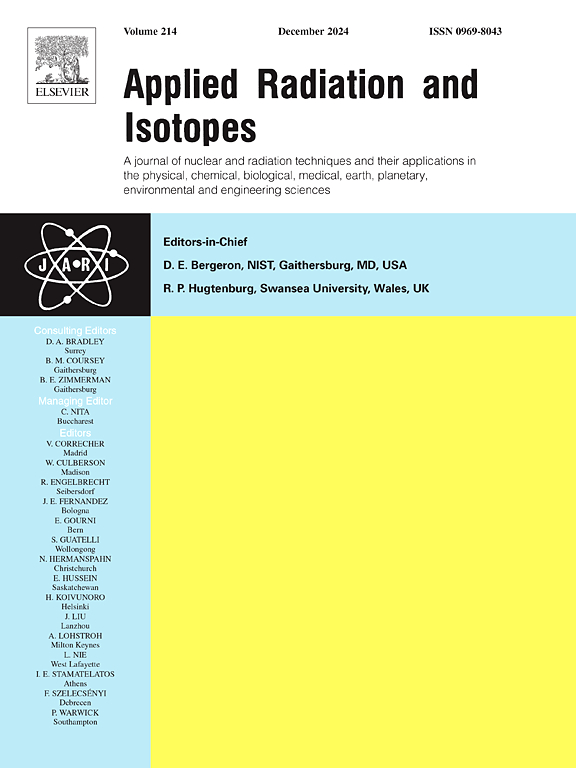用于临床研究的半自动化[13N]氨制备系统的开发与验证
IF 1.6
3区 工程技术
Q3 CHEMISTRY, INORGANIC & NUCLEAR
引用次数: 0
摘要
背景/目的[13N]氨是一种对心脏灌注成像至关重要的PET示踪剂。它的手工生产需要大量的辐射暴露和劳动效率低下。本研究旨在开发和验证一种半自动净化模块,以提高临床研究环境中的安全性、可靠性和效率。方法该系统采用基于单片机的远程控制、精心设计的流体路径和优化的模块灭菌流程。迭代原型指导改进,包括紧凑的热电池兼容尺寸,减少清洁时间,和用户友好的功能。验证包括生产多个[13N]氨批次,根据FDA放射化学纯度、无菌性和质量标准进行评估。结果该模块持续输送高放射化学纯度的[13N]氨,符合所有监管标准。验证试验证明了连续批次的重复性,减少了操作人员的干预和辐射暴露。功能,如自动清洗周期和紧凑的设计提高了操作效率和可用性。该半自动化模块为临床研究中的[13N]氨生产提供了一种实用、低成本的解决方案。它的设计减少了操作人员的接触,增加了再现性,并以一小部分的成本提供了与商用合成器相当的性能。该系统解决了吞吐量和基础设施有限的设施的需求,并可作为全自动化系统的可访问替代方案。本文章由计算机程序翻译,如有差异,请以英文原文为准。
![Development and validation of a semi-automated [13N]Ammonia preparation system for clinical research](https://img.booksci.cn/booksciimg/2025-4/102303191171775936894.jpg)
Development and validation of a semi-automated [13N]Ammonia preparation system for clinical research
Background/Objectives
[13N]Ammonia is a PET tracer critical for cardiac perfusion imaging. Its manual production entails significant radiation exposure and labor inefficiencies. This study aimed to develop and validate a semi-automated purification module to enhance safety, reliability, and efficiency in clinical research settings.
Methods
The system employs microcontroller-based remote controls, carefully designed fluidic pathways, and an optimized module sterilization process. Iterative prototyping guided improvements, including compact hot cell-compatible dimensions, reduced cleaning times, and user-friendly features. Validation involved producing multiple [13N]ammonia batches assessed against FDA standards for radiochemical purity, sterility, and quality.
Results
The module consistently delivered [13N]ammonia with high radiochemical purity and compliance with all regulatory standards. Validation tests demonstrated reproducibility across consecutive batches, reducing operator intervention and radiation exposure. Features such as automated cleaning cycles and compact design enhanced operational efficiency and usability.
Conclusions
This semi-automated module offers a practical, low-cost solution for [13N]ammonia production in clinical research. Its design reduces operator exposure, increases reproducibility, and provides performance comparable to commercial synthesizers at a fraction of the cost. The system addresses the needs of facilities with limited throughput and infrastructure and serves as an accessible alternative to fully automated systems.
求助全文
通过发布文献求助,成功后即可免费获取论文全文。
去求助
来源期刊

Applied Radiation and Isotopes
工程技术-核科学技术
CiteScore
3.00
自引率
12.50%
发文量
406
审稿时长
13.5 months
期刊介绍:
Applied Radiation and Isotopes provides a high quality medium for the publication of substantial, original and scientific and technological papers on the development and peaceful application of nuclear, radiation and radionuclide techniques in chemistry, physics, biochemistry, biology, medicine, security, engineering and in the earth, planetary and environmental sciences, all including dosimetry. Nuclear techniques are defined in the broadest sense and both experimental and theoretical papers are welcome. They include the development and use of α- and β-particles, X-rays and γ-rays, neutrons and other nuclear particles and radiations from all sources, including radionuclides, synchrotron sources, cyclotrons and reactors and from the natural environment.
The journal aims to publish papers with significance to an international audience, containing substantial novelty and scientific impact. The Editors reserve the rights to reject, with or without external review, papers that do not meet these criteria.
Papers dealing with radiation processing, i.e., where radiation is used to bring about a biological, chemical or physical change in a material, should be directed to our sister journal Radiation Physics and Chemistry.
 求助内容:
求助内容: 应助结果提醒方式:
应助结果提醒方式:


